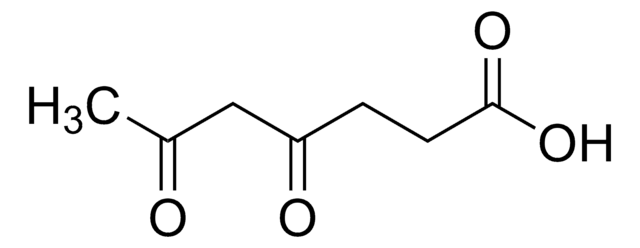The solubility of this material is not tested internally. While literature indicates that it is minimally soluble in water (around 4.6 g/L at 20°C), it should be more soluble in ethanol, methanol, diethyl ether, heptane, hexane, and carbon tetrachloride. Optimal concentration will need to be determined by the end user.
W254606
4-Heptanone
≥97%, FG
Sinônimo(s):
Butyrone, Dipropyl ketone
Selecione um tamanho
Selecione um tamanho
About This Item
Produtos recomendados
fonte biológica
synthetic
Nível de qualidade
grau
FG
Fragrance grade
Halal
Agency
follows IFRA guidelines
conformidade reg.
EU Regulation 1223/2009
EU Regulation 1334/2008 & 178/2002
FDA 21 CFR 117
FDA 21 CFR 172.515
densidade de vapor
3.93 (vs air)
pressão de vapor
5.2 mmHg ( 20 °C)
Ensaio
≥97%
índice de refração
n20/D 1.407 (lit.)
p.e.
145 °C (lit.)
pf
−33 °C (lit.)
densidade
0.817 g/mL at 25 °C (lit.)
aplicação(ões)
flavors and fragrances
Documentação
see Safety & Documentation for available documents
alérgeno alimentar
no known allergens
alérgeno de fragrância
no known allergens
Organoléptico
cheese; fruity; pineapple; sweet
cadeia de caracteres SMILES
CCCC(=O)CCC
InChI
1S/C7H14O/c1-3-5-7(8)6-4-2/h3-6H2,1-2H3
chave InChI
HCFAJYNVAYBARA-UHFFFAOYSA-N
Procurando produtos similares? Visita Guia de comparação de produtos
Categorias relacionadas
Ações bioquímicas/fisiológicas
Outras notas
Palavra indicadora
Warning
Frases de perigo
Declarações de precaução
Classificações de perigo
Acute Tox. 4 Inhalation - Flam. Liq. 3
Código de classe de armazenamento
3 - Flammable liquids
Classe de risco de água (WGK)
WGK 2
Ponto de fulgor (°F)
120.2 °F - closed cup
Ponto de fulgor (°C)
49 °C - closed cup
Equipamento de proteção individual
Eyeshields, Faceshields, Gloves, type ABEK (EN14387) respirator filter
Escolha uma das versões mais recentes:
Já possui este produto?
Encontre a documentação dos produtos que você adquiriu recentemente na biblioteca de documentos.
-
Why 4-heptanone is insoluble?
1 answer-
Helpful?
-
Active Filters
Nossa equipe de cientistas tem experiência em todas as áreas de pesquisa, incluindo Life Sciences, ciência de materiais, síntese química, cromatografia, química analítica e muitas outras.
Entre em contato com a assistência técnica









